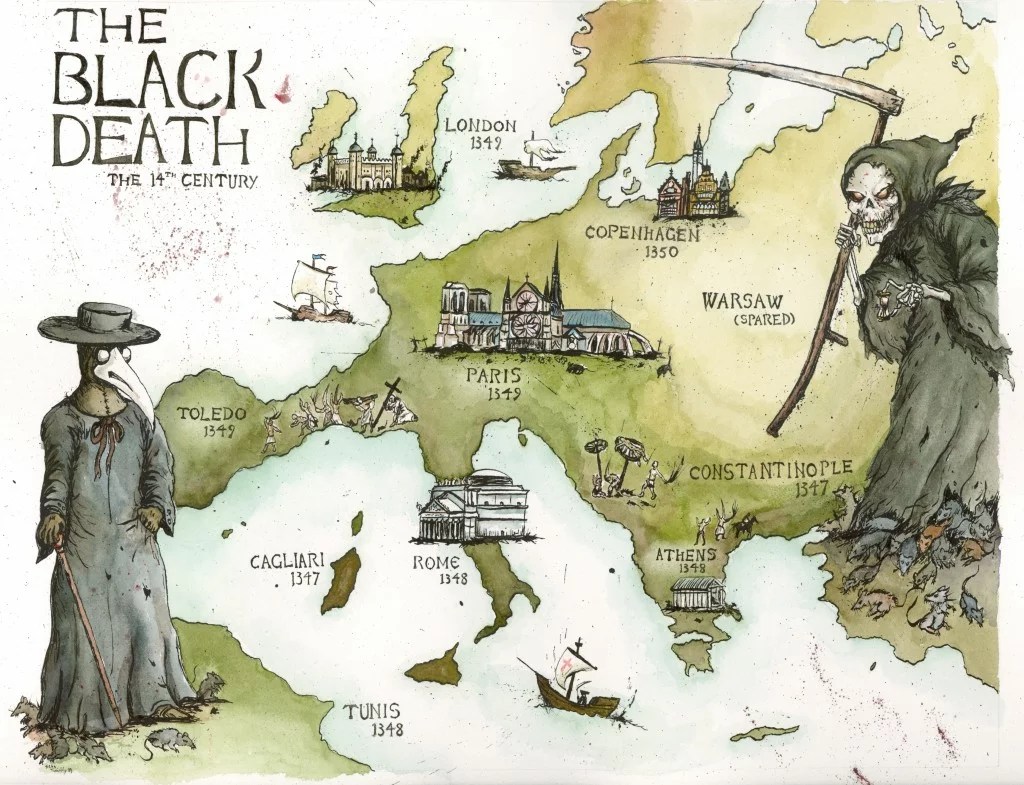The Black Death pandemic is probably one of the deadliest in human history, as the death toll was enormous and the suffering terrible. In Europe alone, an estimated 40-60% of the population died. It took a few centuries for the European population to recover.
The Story of the Black Death
It is said that the ship came from Crimea and Asia in October 1347 and docked at Messina, Sicily. The ship brought not only sailors, but also rats. The Black Death was brought with them, also known as the bubonic plague. The people of Europe already knew about the plague that was killing millions of people in Asia, but they were not worried as they didn’t think it would reach their homeland.
According to one report, 20 million people died as a result of the plague, but only in Asia, which is an understatement considering at least 25 million people died in Europe and Asia is much larger. Half of Paris’s population died when 100,000 people succumbed to bubonic plague. The population of Florence fell from 120,000 in 1351 to just 50,000. The Black Death was practically a catastrophe and unprecedented in human history.
Current meaning
The Black Death wrought so much devastation that it genetically shaped humanity. Even after 700 years, it still affects our health.
Almost half of Europe’s population died in the mid-13th century from the Black Death pandemic, which lasted in waves for centuries.

Scientists have found a genetic mutation that helped humans survive the Black Death after analyzing centuries-old skeletal DNA. But these mutations are linked to people suffering from autoimmune diseases.
The Black Death claimed an estimated 200 million lives. It was certainly one of the darkest and deadliest moments in human history.
Researchers suspect that such an event must have played a role in shaping human evolution. The 206 teeth of ancient skeletons have been analyzed and their date accurately predicted. Some were before, during, and after the Black Death. Included in the analysis were bones from the East Smithfield plague pits. This pit was a site of mass burials in London. There were also samples from Denmark.
This analysis helped locate the mutated gene called ERAP2. This was published in the journal Nature. People were 40% more likely to survive the plague if they had the right mutation.
University of Chicago professor Luis Barreiro said finding something like this in the human genome was both a major impact and a surprise.
The gene’s job is to make a protein that will cut the invading microbes. The protein then signals it to the immune system, which in turn makes the immune system more effective at recognizing and dealing with the enemy.
There are different versions of this gene, which can be divided into two different categories. Some work well and some that do absolutely nothing. So if you were lucky, you would get the working versions of the gene from both parents and most likely survive, and their generations would carry that gene with them.

McMaster University evolutionary geneticist Professor Hendrik Poinar said this was the strongest human selection event to date, with this 10 percent shift in just 2-3 generations.
This was tested in an experiment with the plaque bacterium Yersinia pestis. It was found that the blood of people with beneficial mutations was able to resist infection better than that of people who didn’t have that mutation.

These beneficial mutations are more common today than before the Black Death. The only problem is that they have been linked to autoimmune diseases such as the inflammatory bowel disease called Crones. This helped your ancestors stay alive 700 years ago, but now it could be a health issue.
We can feel the effects of other historical influences on our DNA. Our ability to respond to diseases like COVID is influenced by 1-4% of current human DNA, which comes from the mating of our ancestors with Neanderthals.
Therefore, according to Professor Barreiro, these scars from the past still have a rather amazing impact on our susceptibility to disease today.
The 40 percent survival benefit was the “strongest calculated selected fitness effect in humans,” according to Professor Barreiro. Although he warns that accurate comparisons are difficult, it seems to dwarf the benefit of HIV resistance genes or those that help digest milk.
However, the COVID-19 pandemic will leave no comparable legacy.
Your ability to reproduce and pass on your genes is how evolution works. COVID mainly kills older people who are past reproductive age.
The plague’s ability to kill people of all ages and in large numbers meant it had a long-lasting effect.
Read more: https://asianatimes.com/racism-in-australian-netball-off-court-shutdown/
#Black #Death #History #Current #Importance #Asiana #Times


Leave a Comment